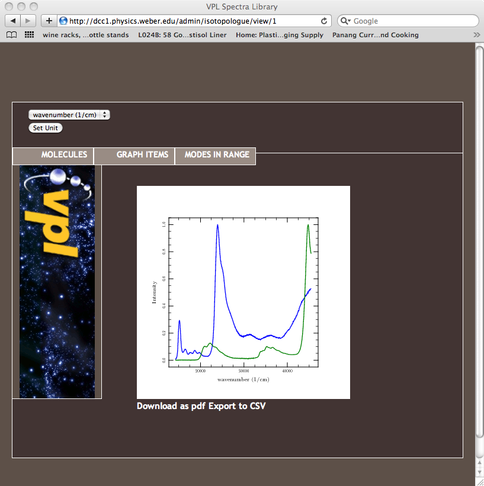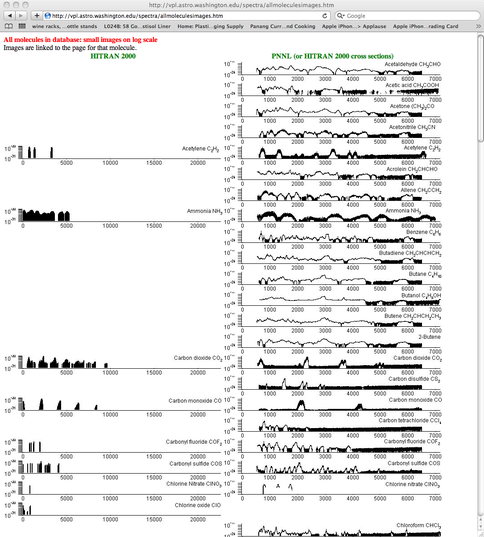2011 Annual Science Report
 VPL at University of Washington
Reporting | SEP 2010 – AUG 2011
VPL at University of Washington
Reporting | SEP 2010 – AUG 2011
VPL Databases, Model Interfaces and the Community Tool
Project Summary
The Virtual Planetary Laboratory (VPL) develops computer models of planetary environments, including planets orbiting other stars (exoplanets) and provides a collaborative framework for scientists from many disciplines to coordinate their research. As part of this framework, VPL develops easier to use interfaces to its models, so that they can be used by more researchers. We also collect and serve to the community the scientific data required as input to the models. These input data include spectra of stars, data files that tell us how atmospheric gases interact with incoming stellar radiation, and plant photosynthetic pigments. We also develop tools that allow users to search and manipulate the scientific input data.
Project Progress
The VPL spectra community tool allows the user to query the HITRAN data and biological pigments as well as view the spectra of molecules that have features in a given wave number (or wavelength) range. The user can zoom into spectral features of interest and look at the spectra of neighboring wave numbers (or wavelengths). Thus the VPL spectra community tool allows users to identify molecules that correspond to spectroscopic features in spectra obtained by satellites or telescopes. We are in the process of porting the development tool to a production server and performing some bug fixes.
Collection of most of the biological pigments was completed in the previous reporting period and continued this year with the assistance of a Columbia astronomy undergraduate, Marina Cassio, under the guidance of Co-I Kiang. FY2010 involved cleaning up bugs in the code, ensuring completeness of metadata, and testing the user interface. The database now has a critical mass of nearly 50 absorbance spectra of photosynthetic and other biological pigments, including chlorophyll f (discovered in 2010) as well as the more common chlorophylls, bacteriochlorophylls, numerous carotenoids, and screening pigments like anthocyanin. Metadata include references for the data sources and descriptions of the data, such as whether it is in vivo or in vitro, what organism it came from, critical features of the spectra, and keywords for searching. Of course, additional spectra continue to be solicited from the community.
This year, we also enlarged the VPL spectroscopic compilation of line parameters to permit modeling high opacity exoplanets. The HITRAN 2008 database was supplemented with massive collections of ab initio predictions. In addition, the CH4 database is continually being. For pressure-induced effects, information on broadeners other than N2 and air are available, and collision-induced absorption continuum cross sections (Rothman, et al. submitted) is being added to the VPL spectroscopic database.
A screenshot of the spectral database tool’s display of pigment spectra. This tool is currently being ported to a production server at the University of Washington.
This is a graphical selection of HITRAN data available to VPL researchers.
Publications
-
Kaltenegger, L., Segura, A., & Mohanty, S. (2011). MODEL SPECTRA OF THE FIRST POTENTIALLY HABITABLE SUPER-EARTH—Gl581d. The Astrophysical Journal, 733(1), 35. doi:10.1088/0004-637x/733/1/35
-
Rothman, L. S., Gordon, I. E., Barber, R. J., Dothe, H., Gamache, R. R., Goldman, A., … Tennyson, J. (2010). HITEMP, the high-temperature molecular spectroscopic database. Journal of Quantitative Spectroscopy and Radiative Transfer, 111(15), 2139–2150. doi:10.1016/j.jqsrt.2010.05.001
-
Tennyson, J., Bernath, P. F., Brown, L. R., Campargue, A., Császár, A. G., Daumont, L., … Voronin, B. A. (2010). IUPAC critical evaluation of the rotational–vibrational spectra of water vapor. Part II. Journal of Quantitative Spectroscopy and Radiative Transfer, 111(15), 2160–2184. doi:10.1016/j.jqsrt.2010.06.012
-
Tinetti, G., Deroo, P., Swain, M. R., Griffith, C. A., Vasisht, G., Brown, L. R., … McCullough, P. (2010). PROBING THE TERMINATOR REGION ATMOSPHERE OF THE HOT-JUPITER XO-1b WITH TRANSMISSION SPECTROSCOPY. The Astrophysical Journal, 712(2), L139–L142. doi:10.1088/2041-8205/712/2/l139
-
Tinetti, G., Griffith, C. A., Swain, M. R., Deroo, P., Beaulieu, J. P., Vasisht, G., … Brown, L. R. (2010). Exploring extrasolar worlds: from gas giants to terrestrial habitable planets. Faraday Discussions, 147, 369. doi:10.1039/c005126h
-
Vance, S., Christensen, L. E., Webster, C. R., & Sung, K. (2011). Volatile organic sulfur compounds as biomarkers complementary to methane: Infrared absorption spectroscopy of CH3SH enables insitu measurements on Earth and Mars. Planetary and Space Science, 59(2-3), 299–303. doi:10.1016/j.pss.2010.08.023
- Armstrong, J., Barnes, R. & Domagal-Goldman, S. (2010). Obliquity variations in stable, high-inclination planetary systems and the impact on the habitable zone. APS Four Corners Section Meeting Abstracts, 4CF: 1001.
- Brown, L.R. (2010). Spectroscopic Databases for Astronomical Applications (invited %speaker). Proceedings for the NASA Laboratory Astrophysics Workshop.
- Brown, L.R., Chen, P., Drouin, B.J., Miller, C.E., Pearson, J., Sander, S.P., Sung, K., Toth, R.A. & Yu, S. White paper for the Planetary Decadal Survey: Laboratory Spectroscopy to Support Remote Sensing of Atmospheric Composition. Jet Propulsion Laboratory, California Institute of Technology, 4800 Oak Grove Drive, Pasadena, CA 91109.
- Domagal-Goldman, S., Barnes, R., Armstrong, J.C., Breiner, J. & Meadows, V.S. (2011). Tilt-a-Worlds: Effects of High Rates of Obliquity Change on the Habitability of Extrasolar Planets. Bulletin of the American Astronomical Society.
-
PROJECT INVESTIGATORS:
-
PROJECT MEMBERS:
David Crisp
Co-Investigator
Victoria Meadows
Co-Investigator
Antigona Segura-Peralta
Co-Investigator
Pramod Gupta
Research Staff
-
RELATED OBJECTIVES:
Objective 1.1
Formation and evolution of habitable planets.
Objective 1.2
Indirect and direct astronomical observations of extrasolar habitable planets.





